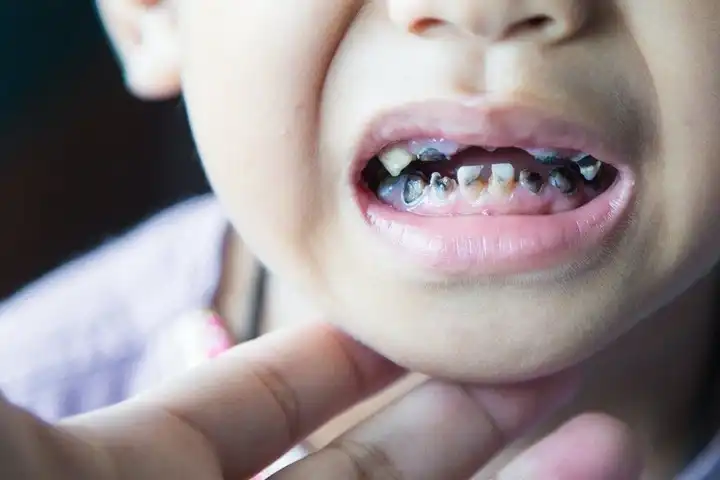Tooth Decay in Children - Causes, Treatment & Prevention


Did you know that tooth decay is one of the most prevalent childhood diseases? In fact, many experts state that for kids, teeth cavities are the leading cause of missed school days. As a parent, your child’s earliest years are some of the most important when it comes to preventing tooth decay on toddlers or older children’s teeth.
Your child’s first set of teeth aren’t as strong or cavity resistant as their adult teeth are. Once tooth decay on toddlers is noted, it spreads quickly. To make matters more challenging, your toddler also craves independence. Fortunately, there are steps you can take to lower the chances of your family dealing with kids’ teeth cavities.
Symptoms Of Rotten Teeth
- not wanting to eat
- swelling or a pimple on the gums
- visible darkness or what looks like staining
- holes in teeth
- putting their hands in their mouth more than normal
Unfortunately, by the time you can see rotten teeth on toddlers, the decay has reached an aggressive stage.
Causes Of Toddlers Rotten Teeth
Since their tooth enamel isn’t as dense as an adult’s, rotten teeth on toddlers are more common. In most cases, it’s because of extended lengths of time where plaque is on the teeth or from frequent snacking throughout the day. For instance, one child might be put down for a nap or to bed with a sippy cup of milk or juice. As those liquids pool across their teeth for the next hour or more, the natural sugars etch away at the enamel on their front teeth.
Diets high in processed carbohydrates, natural sugars, or sticky foods can increase the number of cavity-causing bacteria inside of their mouths. If your child’s teeth aren’t brushed routinely and flossed each day, it will just be a matter of time before the plaque eats through the outer layer of your toddler’s enamel.
Tooth Decay Risks With Children
One of the first responses a lot of people have to rotten teeth on toddlers is, “Oh well, those teeth were going to fall out anyway.” Yes, that’s true, but no it’s not that simple.
- speech impairments
- orthodontic issues
- impacted or crooked adult teeth (due to change in tooth spacing)
- self-esteem issues later on
- digestive problems

Toddler Treatment For Rotten Teeth
When we’re talking about kids’ teeth cavities, it’s important to treat them as soon as possible. That means within a week or so of the decay being diagnosed. Cavities don’t recover; they just get worse. Rotten baby teeth can cause huge problems to the teeth below.
So, what’s the best way to treat cavities in your toddler’s teeth? It depends on how large it is. Preferably, your dentist is catching the decay when it’s small and less invasive, at which point they will recommend a filling. But if the cavity isn’t noticed until it’s already ruptured through those outer layers of enamel, a crown is usually necessary.
Tooth Decay Prevention
Help prevent decaying teeth in toddlers by forming good oral hygiene habits as early as possible. Start by brushing your baby’s teeth as soon as they erupt. The ADA recommends using a rice-grain-sized smear of fluoride toothpaste to help make teeth more cavity resistant. Brush in a circular pattern to clean off all the plaque. Once other teeth start to erupt, be sure to start flossing the sides of every tooth at least once a day.
Between meals, offer your toddler water instead of other types of beverages.
Bring your child to the dentist for a checkup as soon as their first tooth comes in, or no later than their first birthday. Also ask your dentist about fluoride treatment if your child is a little older.
Rotten Teeth In Children Recap
Decaying teeth in toddlers is a serious issue. Unfortunately, tooth decay symptoms usually aren’t visible to parents until they’re severe. Good oral hygiene and a balanced diet are the most important steps to prevent cavities in your toddler.
But for best results, bring your child in for regular checkups by the time they turn 1 year old, so that your dentist can intervene before serious cavities ever have a chance to develop.

Make your inbox smile!
Subscribe






